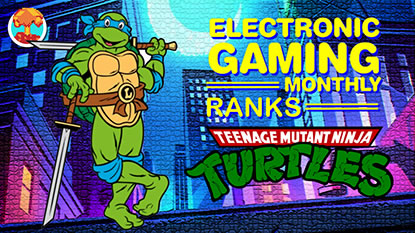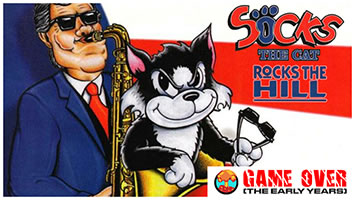- CLASSIC MAGAZINES
- REVIEW CREW
A show recapping what critics thought back
when classic games first came out! - NEXT GENERATION'S BEST & WORST
From the worst 1-star reviews to the best
5-stars can offer, this is Next Generation! - NINTENDO POWER (ARCHIVE)
Experience a variety of shows looking at the
often baffling history of Nintendo Power! - MAGAZINE RETROSPECTIVE
We're looking at the absolutely true history of
some of the most iconic game magazines ever! - SUPER PLAY'S TOP 600
The longest and most ambitious Super NES
countdown on the internet! - THEY SAID WHAT?
Debunking predictions and gossip found
in classic video game magazines! - NEXT GENERATION UNCOVERED
Cyril is back in this spin-off series, featuring the
cover critic review the art of Next Generation! - HARDCORE GAMER MAGAZING (PDF ISSUES)
Download all 36 issues of Hardcore Gamer
Magazine and relive the fun in PDF form!
- REVIEW CREW
- ELECTRONIC GAMING MONTHLY
- ELECTRONIC GAMING MONTHLY RANKS
From Mario to Sonic to Street Fighter, EGM
ranks classic game franchises and consoles! - ELECTRONIC GAMING MONTHLY BEST & WORST
Counting down EGM’s best and worst reviews
going year by year, from 1989 – 2009! - ELECTRONIC GAMING BEST & WORST AWARDS
11-part video series chronicling the ups and
downs of EGM’s Best & Worst Awards!
- ELECTRONIC GAMING MONTHLY RANKS
- GAME HISTORY
- GAME OVER: STORY BREAKDOWNS
Long-running series breaking down game
stories and analyzing their endings! - A BRIEF HISTORY OF GAMING w/ [NAME HERE]
Real history presented in a fun and pithy
format from a variety of game historians! - THE BLACK SHEEP
A series looking back at the black sheep
entries in popular game franchises! - INSTANT EXPERT
Everything you could possibly want to know
about a wide variety of gaming topics! - FREEZE FRAME
When something familiar happens in the games
industry, we're there to take a picture! - I'VE GOT YOUR NUMBER
Learn real video game history through a series
of number-themed episodes, starting at zero! - GREAT MOMENTS IN BAD ACTING
A joyous celebration of some of gaming's
absolute worst voice acting!
- GAME OVER: STORY BREAKDOWNS
- POPULAR SHOWS
- DG NEWS w/ LORNE RISELEY
Newsman Lorne Riseley hosts a regular
series looking at the hottest gaming news! - REVIEW REWIND
Cyril replays a game he reviewed 10+ years
ago to see if he got it right or wrong! - ON-RUNNING FEUDS
Defunct Games' longest-running show, with
editorials, observations and other fun oddities! - DEFUNCT GAMES QUIZ (ARCHIVE)
From online quizzes to game shows, we're
putting your video game knowledge to the test!- QUIZ: ONLINE PASS
Take a weekly quiz to see how well you know
the news and current gaming events! - QUIZ: KNOW THE GAME
One-on-one quiz show where contestants
find out if they actually know classic games! - QUIZ: THE LEADERBOARD
Can you guess the game based on the classic
review? Find out with The Leaderboard!
- QUIZ: ONLINE PASS
- DEFUNCT GAMES VS.
Cyril and the Defunct Games staff isn't afraid
to choose their favorite games and more! - CYRIL READS WORLDS OF POWER
Defunct Games recreates classic game
novelizations through the audio book format!
- DG NEWS w/ LORNE RISELEY
- COMEDY
- GAME EXPECTANCY
How long will your favorite hero live? We crunch
the numbers in this series about dying! - VIDEO GAME ADVICE
Famous game characters answer real personal
advice questions with a humorous slant! - FAKE GAMES: GUERILLA SCRAPBOOK
A long-running series about fake games and
the people who love them (covers included)! - WORST GAME EVER
A contest that attempts to create the worst
video game ever made, complete with covers! - LEVEL 1 STORIES
Literature based on the first stages of some
of your favorite classic video games! - THE COVER CRITIC
One of Defunct Games' earliest shows, Cover
Critic digs up some of the worst box art ever! - COMMERCIAL BREAK
Take a trip through some of the best and
worst video game advertisements of all time! - COMIC BOOK MODS
You've never seen comics like this before.
A curious mix of rewritten video game comics!
- GAME EXPECTANCY
- SERIES ARCHIVE
- NINTENDO SWITCH ONLINE ARCHIVE
A regularly-updated list of every Nintendo
Switch Online release, plus links to review! - PLAYSTATION PLUS CLASSIC ARCHIVE
A comprehensive list of every PlayStation
Plus classic release, including links! - RETRO-BIT PUBLISHING ARCHIVE
A regularly-updated list of every Retro-Bit
game released! - REVIEW MARATHONS w/ ADAM WALLACE
Join critic Adam Wallace as he takes us on a
classic review marathon with different themes!- DEFUNCT GAMES GOLF CLUB
Adam Wallace takes to the links to slice his way
through 72 classic golf game reviews! - 007 IN PIXELS
Adam Wallace takes on the world's greatest spy
as he reviews 15 weeks of James Bond games! - A SALUTE TO VAMPIRES
Adam Wallace is sinking his teeth into a series
covering Castlevania, BloodRayne and more! - CAPCOM'S CURSE
Adam Wallace is celebrating 13 days of Halloween
with a line-up of Capcom's scariest games! - THE FALL OF SUPERMAN
Adam Wallace is a man of steel for playing
some of the absolute worst Superman games! - THE 31 GAMES OF HALLOWEEN
Adam Wallace spends every day of October afraid
as he reviews some of the scariest games ever! - 12 WEEKS OF STAR TREK
Adam Wallace boldly goes where no critic has
gone before in this Star Trek marathon!
- DEFUNCT GAMES GOLF CLUB
- DAYS OF CHRISTMAS (ARCHIVE)
Annual holiday series with themed-episodes
that date all the way back to 2001!- 2015: 30 Ridiculous Retro Rumors
- 2014: 29 Magazines of Christmas
- 2013: 29 Questionable Power-Ups of Christmas
- 2012: 34 Theme Songs of Christmas
- 2011: 32 Game Endings of Christmas
- 2010: 31 Bonus Levels of Christmas
- 2009: 30 Genres of Christmas
- 2008: 29 Controls of Christmas
- 2007: 34 Cliches of Christmas
- 2006: 33 Consoles of Christmas
- 2005: 32 Articles of Christmas
- 2004: 31 Websites of Christmas
- 2003: 29 Issues of Christmas
- 2002: 28 Years of Christmas
- 2001: 33 Days of Christmas
- NINTENDO SWITCH ONLINE ARCHIVE
- REVIEW ARCHIVE
- FULL ARCHIVE
Sega Does What Nintendoes

While Sega is best known for coming up with a number of cool innovations, unfortunately this terribly oversized six button belt buckle is not one of them!
Sega released the Sega Master System in 1986 (aka the Mark III) in order to directly compete with the Nintendo Entertainment System (NES). Even while the Famicom controlled 90% of the market in Japan, Sega decided
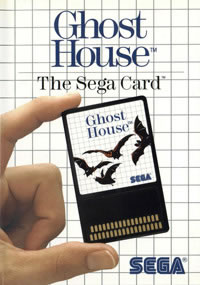
Sure it has the worst cover art ever, but when it came to the Sega Master System you always knew when you were getting a card-based game!
Nintendo had the name recognition, the larger marketing budget, and its games with tight limitations for third-parties. Also, third party developers that created a game for Nintendo's 8-bitter could not release that game for a different console. Guaranteed exclusives are guaranteed cash, no matter if the games are good or not. Despite these advantages, though, Sega had a few cards up their sleeve, including innovation above and beyond the card-based data of the Master System.

If the 1950s have taught us anything it's that 3D glasses suck (and that giant radioactive animals are super scary)!
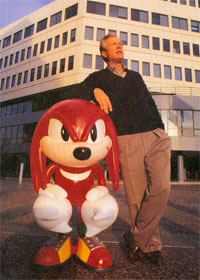
Tom wasn't afraid of going against Nintendo when it really mattered! Then again, he wasn't afraid of wearing pleated pants, so perhaps his style was a bit iffy!
In terms of marketing, Sega also innovated greatly. They were the company that publicly called out Nintendo and gave video games real attitude. The "SEGA scream" is something that any gamers from that time frame are familiar with. Sega's Genesis (aka Mega Drive), teamed up with the speed and attitude of Sonic the Hedgehog, brought them an entirely new audience of older gamers that had grown up with Atari. Their "Genesis Does What Nintendon't" campaign was actually so effective that Nintendo responded with, "Nintendo is What Genesisn't." Marketing went beyond the commercials, however, and brought in a price war. Sega new-comer Tom Kalinske, already known as the man behind the He-Man marketing push, quickly cut prices on the Genesis $40 and introduced the now-industry standard idea of losing money on the console
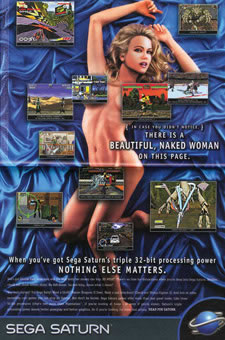
Sega's edgy (adult focused) advertising didn't stop at the 16-bit era, unfortunately it lost some subtlety when they simply decided to go with naked women!
When Nintendo came out with the Super Nintendo (aka Super Famicom) in 1991 the battle lines changed. No longer was the 16-bit Genesis competing against the 8-bit NES. The Super Nintendo had some challenges to face, since the Genesis was being sold cheaper, had been out longer, and featured a wider variety of games to choose from. Marketing had given Sega an older audience. Also, they released more first-party games per year, no censorship rules for the games they released, and Sega still had the thinking of an underdog. It was in the last aspect, however, that would do them in.
To be fair, the Genesis had a number of wonderful ideas and inventions applied to it. Take, for example, Sonic and Knuckles. On the heels of Sonic the Hedgehog 3, Sega could easily have put out a game where Sonic has to read a newspaper while on
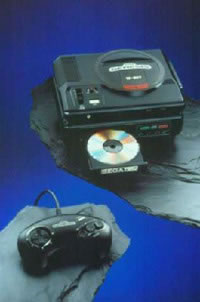
If it wasn't for Sega add-ons like the Sega CD and Sega 32x what would Defunct Games even talk about?
Additionally, Sega wasn't yet done innovating with their hardware, and they never got past the idea that their console was technologically inferior to the Super Nintendo. They decided to add-on to their system, releasing both the Sega CD and the Sega 32X in short order. With high prices, the requirement of a Genesis for the add-ons to work, an already announced new console called Saturn, and a serious lack of quality games, both of these innovative ideas failed almost before being introduced. It's certainly worth noting, however, that
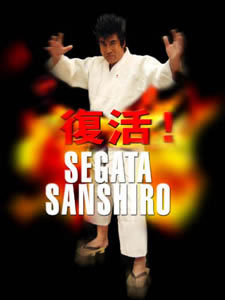
Segata is perhaps the best thing to come out of the 32-bit Saturn era!
Both of the consoles that followed in the wake of the Genesis also featured innovations. The Sega Saturn was a very difficult machine to program for, mainly because it was designed around multiple processors in order to increase performance. Modern consoles consider this to be standard practice, although the Saturn's was poorly executed and drowning in technological bottlenecks. It was also one of the first consoles to have useable online functionality (the Genesis and Super Nintendo both experimented with online options, but had very slow modems and limited usability) and featured a dial-up 28.8kbps modem and Sega's NetLink service.
Sega's Dreamcast would continue the online tradition, featuring a built-in 33.6kbps modem (later upgraded to 56.6kbps) and Sega's SegaNet
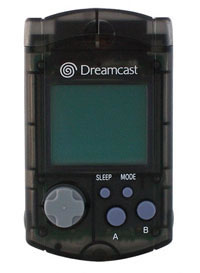
Sure it didn't get used for anything cool, but the idea of the VMU was still light years beyond any other memory card of the time!
Even in the world of system compatibility, Sega tried to be as innovative as possible. Their Game Gear could play Master System games using the Master Gear, although the increased color palette of the Game Gear
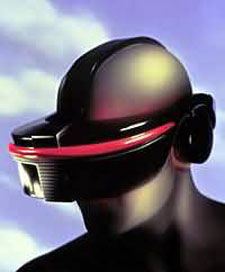
Sega's innovations don't just end with the stuff that came out; Sega is full of innovative ideas that never saw the light of day ... like this crazy (and ill-conceived) virtual reality helmet!
Sega is pretty much out of the hardware business these days and their games simply aren't what they used to be, and that is a shame. In reality, they're nothing but a pale shadow of what they once were. The upstart couldn't beat out Nintendo in the end, but they gave us many innovations that help make gaming what it is today. It's no wonder that every time a website or magazine prints a "new Sega console" rumor the net goes nuts. Let's face it; Nintendo did a lot more innovation when they had Sega in the other corner, staring them down. I'm not ashamed to admit that I miss those days. There are probably plenty of Sega innovations that someone out there loves that I didn't cover, and I admit that, but I think the picture is pretty clear. Without Sega and their competition with Nintendo, the video game industry would be vastly different than what it is.
Ultimate History of Video Games, Stephen L. Kent
The Internet in general. Thanks, Internet!


HOME |
CONTACT |
NOW HIRING |
WHAT IS DEFUNCT GAMES? |
NINTENDO SWITCH ONLINE |
RETRO-BIT PUBLISHING
Retro-Bit |
Switch Planet |
The Halcyon Show |
Same Name, Different Game |
Dragnix |
Press the Buttons
Game Zone Online | Hardcore Gamer | The Dreamcast Junkyard | Video Game Blogger
Dr Strife | Games For Lunch | Mondo Cool Cast | Boxed Pixels | Sega CD Universe | Gaming Trend
Game Zone Online | Hardcore Gamer | The Dreamcast Junkyard | Video Game Blogger
Dr Strife | Games For Lunch | Mondo Cool Cast | Boxed Pixels | Sega CD Universe | Gaming Trend
Copyright © 2001-2025 Defunct Games
All rights reserved. All trademarks are properties of their respective owners.
All rights reserved. All trademarks are properties of their respective owners.













